保留内固定治疗胸腰椎术后感染的体会
王绍钱+王徽+牛磊
[摘要] 目的 探讨在保留内固定情况下,经过换药、病灶清除、扩创引流及使用敏感抗生素等一系列治疗手段,治愈胸腰椎术后感染的可行性。 方法 回顾性分析2012年1月~2015年5月合肥市第二人民医院收治的16例胸腰椎术后感染患者临床资料。在保留内固定情况下,经过一系列换药、扩创、冲洗引流及使用敏感抗生素等积极治疗,观察切口愈合情况。对比分析治疗前后白细胞(WBC)计数、血沉(ESR)、C-反应蛋白(CRP)及疼痛视觉模拟评分法(VAS)评分。 结果 所有患者切口愈合良好。随访6个月~2年,无患者复发。治疗后WBC计数、ESR、CRP及VAS评分均较治疗前降低,差异有统计学意义(P < 0.05)。 结论 应早期明确诊断胸腰椎术后感染,及时积极采取换药、病灶清除、冲洗引流等积极治疗,在保留内固定的情况下,也可获得良好效果。
[关键词] 胸腰椎;内固定;治疗;白细胞计数;血沉;C-反应蛋白
[中图分类号] R681.530 [文献标识码] A [文章编号] 1673-7210(2018)01(c)-0081-04
[Abstract] Objective To explore the feasibility of treating postoperative infection of thoracolumbar spine in the case of retaining internal fixation with a series of treatment methods, such as changing drugs, removing the lesion, expanding the drainage and using sensitive antibiotics. Methods The clinical data of 16 patients with postoperative infection of thoracolumbar spine treated in the Second People's Hospital of Hefei from January 2012 to May 2015 were analyzed retrospectively. In the case of retaining internal fixation, after a series of treatment methods, such as changing drugs, removing the lesion, expanding the drainage and using sensitive antibiotics, the wound healing was observed. The white blood cell (WBC) number, erythrocyte sedimentation rate (ESR), C-reactive protein (CRP) and visual analogous scale (VAS) were analyzed and compared before and after treatment. Results All patients wound healing were well. Follow-up time was from 6 months to 2 years, and no case recurred. After treatment, the WBC number, ESR, CRP and VAS score were lower than those before treatment, with statistically significant difference (P < 0.05). Conclusion It is necessary to clearly diagnose the postoperative infection of thoracolumbar spine in the early stage, and actively take the active treatment, such as changing drugs, removing the lesion, washing the drainage, etc. In the case of retaining internal fixation, it can also achieve good curative effect.
[Key words] Thoracolumbar spine; Internal fixation; Treatment; White blood cell count; Erythrocyte sedimentation rate; C-reactive protein
胸腰椎術后感染是脊柱外科常见且严重并发症之一,随着内固定装置广泛使用,诊治不及时,感染可能会带来灾难性的后果[1]。胸腰椎术后感染往往会使患者痛苦增加,经济负担加重,病程延长,疗效变差,也会使病患对医生、医院的满意度降低,也是医患纠纷的潜在因素。脊柱内固定术后感染的治疗可分3种:第一,长期换药、抗感染治疗;第二,取出内固定,病灶清除,冲洗引流,卧床制动,待感染控制后再植入或不植入内固定;第三,保留内固定,辅助换药、病灶清除,冲洗引流,抗感染等一系列治疗手段[2-3]。本文回顾性分析合肥市第二人民医院(以下简称“我院”)骨科共收治的16例胸腰椎术后感染患者,在保留内固定装置情况下,经过一系列换药、病灶清除,扩创冲洗引流(手术为1~3次),抗感染等治疗的可行性。现将结果报道如下:
1 资料与方法
1.1 一般资料
选取我院2012年1月~2015年5月共收治的16例胸腰椎术后感染患者作为研究对象,其中,男10例,女6例;年龄30~65岁,平均46.5岁;胸12压缩性骨折1例,腰1压缩性骨折2例,腰1爆裂性骨折伴双下肢不全瘫1例,腰3爆裂性骨折1例,腰椎滑脱症3例,腰椎间盘突出症4例,腰椎管狭窄症4例。表浅感染6例,深部感染10例,感染发生时间为术后第6~20天。endprint

